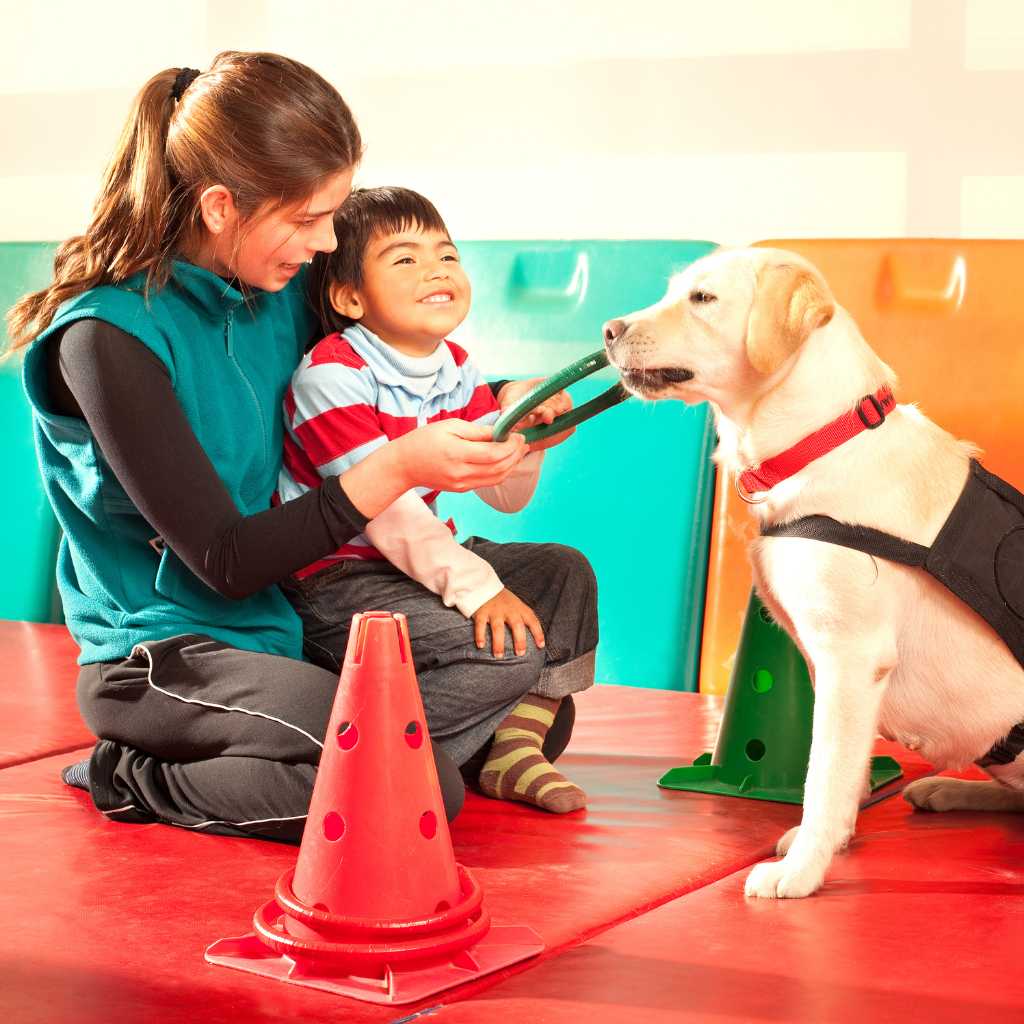Table of Contents
How does animal therapy help children with autism?
When parents receive an Autism Spectrum Disorder (ASD) diagnosis for their child, one of their first questions is, “What therapies can help?”
Among the emerging approaches, animal therapy for autism has been gaining increasing attention. While it is essential to consider each individual’s unique challenges, strengths, talents, preferences, and needs, fortunately, some options can support the development of individuals on the autism spectrum.
So, how does animal therapy help children with autism? While animal-assisted therapy is not a cure, it offers a complementary approach that can significantly enhance the quality of life for children and adults with autism. Numerous studies indicate that interaction with therapy animals for autism can reduce stress and anxiety and improve communication, physical mobility, emotional regulation, and social skills.
This powerful and effective method is an excellent option to consider in autism care.
This guide by ABA Centers of Connecticut explores the fundamentals of animal therapy for autism, its benefits, and key considerations for incorporating it into autism care. So, keep reading!
What Is Animal Therapy?
Animals have a vital role in human lives, providing companionship, support, and even aiding in various tasks. Their presence can bring peace, comfort, and emotional stability to their owners. In recent years, this connection has evolved into structured therapeutic interventions known as Animal-Assisted Therapy (AAT) and Animal-Assisted Activities (AAA), both of which have shown significant benefits in healthcare and education, particularly for children. It harnesses the natural bond between humans and animals to achieve specific goals, whether they be emotional, social, or physical.

AAT vs. AAA
- Animal-Assisted Therapy (AAT): AAT is a structured, goal-oriented intervention conducted by trained healthcare professionals, such as occupational therapists, to achieve specific therapeutic outcomes. It often involves animals as facilitators for prescribed movements or exercises, such as brushing a dog to improve motor skills.
- Animal-Assisted Activities (AAA): AAA is less formal and focuses on providing comfort and companionship. Activities such as “meet-and-greet” visits with therapy animals in hospitals aim to enhance emotional well-being without a structured treatment plan.
While both approaches harness the benefits of human-animal interaction, AAT is a targeted therapeutic practice, whereas AAA offers general emotional and social enrichment.
At the heart of both methodologies lies the human-animal bond, which fosters trust, comfort, and growth. Many individuals with autism find it easier to relate to animals than humans, making this connection particularly valuable.
Animal Therapy for Autism: Learn the Benefits

A recent investigation published in the Journal of Education and Social Sciences highlights the profound impact of AAT on children’s mental, physical, and social well-being. Researchers have found that interactions with animals provide a wide range of benefits, including:
- Emotional Support and Stress Reduction
Therapy animals for autism can create a calming environment that reduces anxiety and emotional distress. Petting or enjoying the presence of an animal can help individuals release oxytocin, a hormone that promotes relaxation and reduces stress.
- Social Skills Development
One of the common challenges for individuals with autism is developing social and communication skills. Therapy animals can serve as bridges to human interaction.
For example, activities like instructing a therapy dog to sit or engaging in guided activities with a horse can help children practice verbal commands, eye contact, and cooperative behaviors.
- Sensory Regulation
Many individuals with autism can experience sensory processing difficulties. Interaction with animals provides tactile, rhythmic, or motion-based sensory input, helping to regulate overstimulated or under-stimulated sensory systems. For instance, the repetitive sensation of stroking a cat’s soft fur can provide soothing tactile input, or horseback riding offers rhythmic motion that helps regulate sensory experiences and balance.
- Improvement in Motor Skills
Animal therapy for autism often involves physical activities that enhance motor coordination and strength. For example, horseback riding develops balance and stability, and playing games like fetch with a therapy dog improves hand-eye coordination. Over time, these activities translate into better physical function and mobility.
- Physical Benefits
According to Psychological Studies, animal therapy can improve blood pressure, heart rate, and improvement in symptoms of depression, anxiety, quality of life, and loneliness.
- Building Self-Confidence
Interacting with therapy animals occurs in a non-judgmental environment, helping individuals with autism feel safe and capable. Successfully communicating with an animal, completing a task, or simply bonding with a therapy animal can boost self-esteem.
Autism and Animal Therapy: Types of Intervention
There are different types of animal therapy for autism, and choosing the right approach for your loved one requires consideration of their individual needs and preferences. Each type of intervention offers specific benefits that can help.
1. Dog-Assisted Therapy
Autism therapy dogs receive training to enhance social interaction and emotional regulation. These highly empathetic animals establish natural bonds with humans and can help to meet specific therapeutic goals, such as reducing stress or improving concentration. Studies have shown that therapy animals for autism, particularly dogs, can encourage prosocial behavior and decrease challenging behaviors in children with ASD.

2. Equine Therapy
Therapeutic horseback riding teaches balance and coordination while the animal’s rhythmic movement provides soothing sensory stimulation. Many equine therapy programs also incorporate activities to strengthen social and emotional skills, making it one of the most comprehensive forms of animal therapy for autism.
3. Dolphin Intervention
Some studies have indicated improvements in attention and concentration in children with ASD after interacting with dolphins. These animals, known for their intuitive and calm nature, create an immersive and relaxing therapeutic environment. Dolphin-assisted therapy often combines water activities with direct interaction, promoting sensory experiences that reduce anxiety and improve social skills. Their playful behavior and ability to connect with humans make them excellent emotional support animals for autism.
4. Small Animal Therapy
Rabbits, cats, and guinea pigs can offer emotional support and help reduce anxiety in children with ASD. They are easy to care for and provide a calming and comforting presence, making them ideal for those who may be intimidated by larger animals. In school settings, teachers have observed a decrease in challenging behaviors and an increase in social interaction when students interact with guinea pigs in the classroom.
Emotional Support Animals and Their Impact on Autism
Emotional support animals are not only intended for structured therapy but can also be part of the daily life of people with ASD. The presence of a pet in the home can foster autonomy and provide emotional stability in children with autism.
Autism service dogs, for example, can help children with sensory difficulties by providing a sense of calm and security. They can also intervene in emotional crises, helping the person to regulate their emotions effectively.
Potential Limitations and Risks of Therapy Animals for Autism
While animal therapy for autism offers significant benefits, there are important considerations to keep in mind.
- Allergies and Health Risks: Interactions with animals can pose risks such as allergies, infections, and, in some cases, accidents (e.g., bites or scratches). Hygiene protocols, such as regular handwashing and veterinary screenings, mitigate these risks.
- Triggering Traits or Fear: Some individuals with autism might feel overstimulated or frightened around certain animals. Careful pre-assessment and monitoring are essential.
- Accessibility and Cost: Families may face location or financial limitations in accessing trained therapy animals and certified programs. We recommend exploring local organizations or subsidies that may help address this challenge.
Enhancing Animal Therapy for Autism with ABA Centers of Connecticut
Animal therapy for autism offers invaluable benefits, fostering emotional connections, reducing anxiety, and enhancing communication skills. However, when combined with Applied Behavior Analysis (ABA) therapy, its impact becomes even more profound. The structured approach of ABA therapy helps reinforce positive behaviors and skill-building, while therapy animals for autism provide emotional support, creating a more engaging and comforting therapeutic experience. This synergy allows for a well-rounded, personalized intervention that addresses both behavioral and emotional needs.
At ABA Centers of Connecticut, we believe in the power of tailored, comprehensive care. Integrating animal therapy for autism into ABA sessions ensures that children receive the best of both worlds—evidence-based behavioral strategies alongside the calming and motivational presence of emotional support animals. This holistic approach leads to long-term progress in emotional regulation, sensory processing, social interaction, and overall development, ultimately improving the quality of life for children on the autism spectrum.

If you’re looking for specialized autism care services, ABA Centers of Connecticut is here to help. Our team provides high-quality, individualized therapy that meets each child’s unique needs. Call us today at (844) 395-0448 or connect online to discover how ABA therapy, combined with animal therapy for autism, can support your loved one’s growth and well-being.









